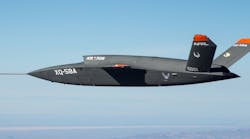The XQ-58A Valkyrie, a prototype for a long-range unmanned drone, completed its first flight on March 5 at the Yuma Proving Grounds in Arizona. It was designed and built by the Air Force Research Laboratory in conjunction with Kratos Unmanned Aerial Systems, a company that has earned a reputation for building reliable drones. The two organizations took just 2.5 years to bring the program to its first flight test.
The multi-mission XQ-58A was designed to handle surveillance, strike, electronic warfare, and fly missions independently as part of an autonomous and cooperative swarm of drones, or as a “loyal wingman.” Loyal wingman is a new concept, defined as having a piloted combat aircraft (most likely an F-22 or F-35) fly and control a drone during a mission.
The drone is said to have a range of over 2,000 miles, a mission ceiling of about 45,000 ft, and a top speed of 652 mph (Mach 0.85). It can carry up to 500 lb of bombs, most likely two Small Diameter Bombs (GBU-39/B) in ,an internal bay or under each wing.


